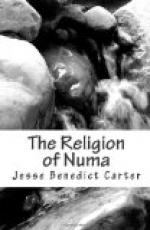of these facts. The facts themselves were of
slow growth, covering probably centuries, but the
actions resulting from them, and the outward changes
in society, came thick and fast and may well have taken
place, all of them, within the limits of one man’s
life. The foundation fact upon which all these
changes were based is the influence of the outside
world on the Roman community. Until this time
there had been little to differentiate Rome from any
other of the hill-communities of Italy, of which there
were scores in her immediate neighbourhood; nor was
she the only one to come into contact with the outside
world. It was the effect which that influence
had upon her as contrasted with her neighbours which
made the difference. When we ask why this influence
affected her differently we find no satisfactory answer,
and are in the presence of a mystery—the
world-old insoluble mystery of the superiority of one
tribe or one individual over others apparently of
the same class. Political history is wont to
tell this chapter of Rome’s story under the title
of the “Rise of the Plebeians,” but the
presence of the Plebeians was only the outward symbol
of an inward change. This change was the breaking
up of the monotonous one-class society of the primitive
community with its one—agricultural—interest,
and the formation of a variegated many-class society
with manifold interests, such as trade, handicraft,
and politics. It was the awakening of Rome into
a world-life out of her century-long undisturbed bucolic
slumber.
There were at this time two peoples in Italy, who
by reason of their older culture were able to be Rome’s
teachers. One lay to the north of her, the mysterious
Etruscans, whose culture fortunately for Rome had
only a very moderate influence, because the Etruscan
culture had already lost much of its virility, possibly
also because it was distinctly felt to be foreign,
and hence could effect no insidious entry, and probably
because Rome was at this time too strong and young
and clean to take anything but the best from Etruria.
The other lay to the south, the Greek colonies of
Magna Graecia, separated from Rome for the present
by many miles of forest and by hostile tribes.
Around her in Latium were her own next of kin, the
Latins, becoming rapidly inferior to her, but enabled
to do her at least this service, that of absorbing
the foreign influences which came, and in certain
cases latinising them, and thus transmitting them
to Rome in a more or less assimilated condition.
The three great facts in the life of Rome during this
period are the coming of Greek merchants and Greek
trade from the south, the coming of Etruscan artisans
and handicraft from the north, and the beginnings of
her political rivalry and gradual prominence in the
league of Latin cities around her. Each one of
these movements is reflected in the religious changes
of the period. In regard to the first two this
is not surprising, for the ancient traveller, like




